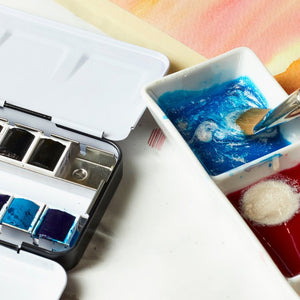
Winsor & Newton has a long history of innovation. We explore five of the company’s key contributions to watercolour painting, and their lasting impact.
Introduction of moist watercolour cakes
Winsor & Newton was established by the combined efforts of chemist William Winsor and professional artist Henry Newton at the beginning of the 19th century. But it was Henry who supervised the watercolour laboratory and brought watercolours right up to date as we know them today, in little pans of completely soluble paint which work at the touch of a wet brush. This apparent ‘magic’ was brought about using glycerine instead of honey, which was first introduced to the market with Winsor & Newton’s moist watercolour cakes in 1835.

Professional Watercolour Field Box: enabling plein air painting
This new discovery led to fresh markets for the modern watercolour medium. The ability to paint en plein air, or out in the field, was enabled with the creation of various paint box sets, particularly the water bottle box, known today as the Professional Watercolour Field Box. Artists could now document flowers, farm animals and newly explored overseas landscapes in colour with ease and accuracy. Featuring a unique pocket-sized set with a water bottle and cup as part of the case, the set opens up to reveal watercolour half pans, mixing areas and brush storage mounted on the inside of the water container.

Series 7 Kolinsky Watercolour Brushes: fit for royalty
The company’s devotion to expertly crafting quality artists’ brushes was royally acknowledged in 1866 by Queen Victoria. The Queen requested that Winsor & Newton produce the finest watercolour brush in her favourite size: the No. 7. The result of this royal order was the Series 7 Kolinsky Watercolour Brush range, a revolutionary watercolour brush series that provided unprecedented control over the flow and spread of paint, allowing for more subtle gradient work and delicate detail, and is considered the company’s finest brush to this day.
The longevity of the Series 7 was unintentionally put to the test when one was uncovered during a salvage operation on the Titanic. When recovered, the brush head still looked as though it had just been bought. This magic trick owes itself to the brush’s Siberian weasel hairs, which are exceptionally robust and strong due to the harsh Arctic conditions the animals must endure.

Educational 'One Shilling Handbooks'
Winsor & Newton went on to create a series of books written specifically for the student and amateur by well-known artists, often referred to as the ‘One Shilling Handbooks’. These instructional books were progressive for their time because they helped educate amateur artists and hobbyists who wanted to learn but didn’t attend art school, where the majority of art tuition could be found. Monochrome and colour handbooks on watercolour painting include The Art of Flower Painting in Watercolours, Hints on Sketching in Watercolour, Landscape Painting in Watercolours and Modern Watercolour Pigments.
Winsor & Newton continues this approach to educating artists through our collection of resources.

Modern Innovations: Promarker Watercolours
Pushing the boundaries of watercolour painting, Winsor & Newton have transformed it from a traditional medium to a medium for modern works of art. New products began to take off during the early 20th century when the company developed pigment dispersions, which allowed for the production of a range of high-quality watercolour paints. This research led the way for the development of the Watercolour Marker that was introduced into the Promarker family in 2020, providing artists with new tools for creating painterly effects. The range contains 35 specially selected watercolour pigments, which are triple-milled to ensure optimal performance and maximum colour permanence.
From the development of more advanced painting tools to innovative new technologies, the legacy left by Winsor & Newton in the field of watercolour painting is tremendous. What began as mere experiments in a watercolour laboratory soon transformed the way in which watercolours were used across the world.




![WN PWC KAREN KLUGLEIN BOTANICAL SET [OPEN 3]](http://www.winsornewton.com/cdn/shop/files/136448.jpg?crop=center&v=1761625362&width=20)
![WN PWC KAREN KLUGLEIN BOTANICAL SET [FRONT]](http://www.winsornewton.com/cdn/shop/files/136444.jpg?crop=center&v=1761625362&width=20)
![WN PWC ESSENTIAL SET [CONTENTS 2]](http://www.winsornewton.com/cdn/shop/files/137579.jpg?crop=center&v=1761625558&width=20)
![WN PWC ESSENTIAL SET [FRONT]](http://www.winsornewton.com/cdn/shop/files/137583.jpg?crop=center&v=1761625558&width=20)
![W&N GALERIA CARDBOARD SET 10X12ML 884955097809 [OPEN]](http://www.winsornewton.com/cdn/shop/files/138856.jpg?crop=center&v=1761626083&width=20)
![W&N GALERIA CARDBOARD SET 10X12ML [B014096] 884955097809 [FOP]](http://www.winsornewton.com/cdn/shop/files/138855.jpg?crop=center&v=1761626083&width=20)
![W&N PROMARKER 24PC STUDENT DESIGNER 884955043295 [OPEN]](http://www.winsornewton.com/cdn/shop/files/78675_d6356b09-bd48-4280-8df1-eefc85a4de3b.jpg?crop=center&v=1761841229&width=20)
![W&N PROMARKER 24PC STUDENT DESIGNER 884955043295 [FRONT]](http://www.winsornewton.com/cdn/shop/files/78674_d4d78a69-7150-4bf4-a504-3cb5304b0f80.jpg?crop=center&v=1721326116&width=20)

![W&N PROFESSIONAL WATER COLOUR TYRIAN PURPLE [SWATCH]](http://www.winsornewton.com/cdn/shop/files/136113.jpg?crop=center&v=1724423390&width=20)
![W&N WINTON OIL COLOUR [COMPOSITE] 37ML TITANIUM WHITE 094376711653](http://www.winsornewton.com/cdn/shop/files/9238_5073745e-fcfe-4fad-aab4-d631b84e4491.jpg?crop=center&v=1721326117&width=20)
![W&N WINTON OIL COLOUR [SPLODGE] TITANIUM WHITE](http://www.winsornewton.com/cdn/shop/files/131754_19b392ee-9bf6-4caf-a2eb-0356ec1c660a.jpg?crop=center&v=1721326118&width=20)